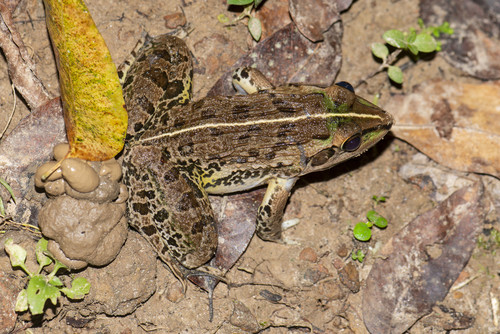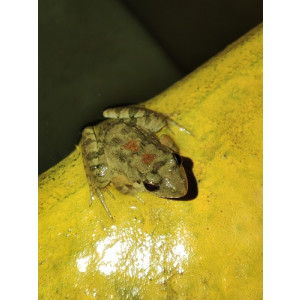@Vijay Anand Ismavel ( inaturalist.org)

Coastal Bullfrog Did you see this animal?
Scientific Name : Hoplobatrachus litoralis
Family : Dicroglossidae
Order : Anura
Class : Amphibia
Phylum : Chordata
Other Name : Coastal Bullfrog
Habitat : Nocturnal/Forests
Description : The Mangrove Bullfrog also known as coastal bullfrog. Females reaching lengths of up to 15 centimeters and males slightly smaller. They have a distinctive coloration with a greenish-brown back and a white or cream-colored belly. Their skin is smooth and moist, and they have large, bulging eyes that provide them with excellent vision.
Mangrove Bullfrogs have strong, muscular hind legs that are adapted for jumping and swimming. Their hind feet are webbed, which helps them move efficiently through water and mud.
The species is capable of tolerating a wide range of salinity levels, which allows them to live in both freshwater and brackish habitats.
Mangrove Bullfrogs are known to be vocal and produce a variety of calls, including alarm calls and distress calls. Males have a darker throat and vocal sac, which they use to amplify their calls during the breeding season.
This species is commonly found in and around mangrove forests, as well as other coastal habitats such as estuaries and brackish marshes. They are also sometimes found in freshwater habitats such as ponds and streams. Mangrove Bullfrogs are mostly nocturnal and feed on a variety of prey, including insects, spiders, and small invertebrates.
Mangrove Bullfrogs have ability to produce a toxic secretion from their skin. This secretion is thought to deter predators from attacking them, and may also have antimicrobial properties that help protect the frog from infections.
During the breeding season, males produce a loud, repetitive call to attract females. Males will aggressively defend their breeding territories from other males, and will engage in physical combat if necessary.
Unfortunately, populations of Mangrove Bullfrogs have been impacted by habitat loss and degradation
Mangrove Bullfrogs have strong, muscular hind legs that are adapted for jumping and swimming. Their hind feet are webbed, which helps them move efficiently through water and mud.
The species is capable of tolerating a wide range of salinity levels, which allows them to live in both freshwater and brackish habitats.
Mangrove Bullfrogs are known to be vocal and produce a variety of calls, including alarm calls and distress calls. Males have a darker throat and vocal sac, which they use to amplify their calls during the breeding season.
This species is commonly found in and around mangrove forests, as well as other coastal habitats such as estuaries and brackish marshes. They are also sometimes found in freshwater habitats such as ponds and streams. Mangrove Bullfrogs are mostly nocturnal and feed on a variety of prey, including insects, spiders, and small invertebrates.
Mangrove Bullfrogs have ability to produce a toxic secretion from their skin. This secretion is thought to deter predators from attacking them, and may also have antimicrobial properties that help protect the frog from infections.
During the breeding season, males produce a loud, repetitive call to attract females. Males will aggressively defend their breeding territories from other males, and will engage in physical combat if necessary.
Unfortunately, populations of Mangrove Bullfrogs have been impacted by habitat loss and degradation
Distribution in Bangladesh
References:
description written by: Md. Shalauddin, Department of Zoology, Jagannath University, Dhaka. Information sources: IUCN Red List Bangladesh-2015, Hasan 2014, Khan 2018 (Photographic guide to the wildlife of Bangladesh).photo credit:ivijayanand(www.inaturalist.org/people/ivijayanand),photo copyright: iNaturalist. more information please contact with us.
description written by: Md. Shalauddin, Department of Zoology, Jagannath University, Dhaka. Information sources: IUCN Red List Bangladesh-2015, Hasan 2014, Khan 2018 (Photographic guide to the wildlife of Bangladesh).photo credit:ivijayanand(www.inaturalist.org/people/ivijayanand),photo copyright: iNaturalist. more information please contact with us.



















